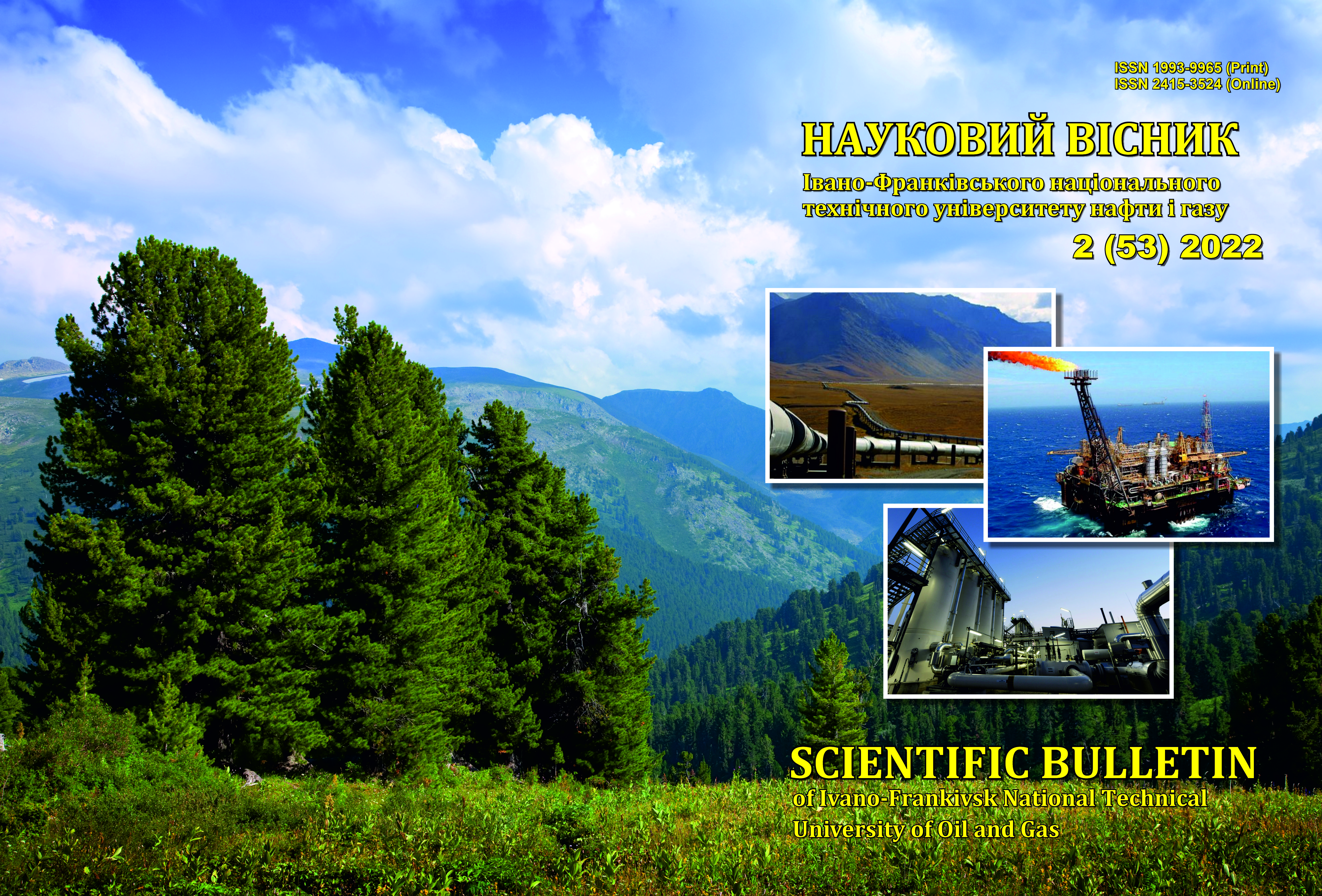Study of the kinematic radial work flow of a well jet pump
DOI:
https://doi.org/10.31471/1993-9965-2022-2(53)-23-30Keywords:
borehole jet pump, ejection system, potential flows, hydrodynamic functions, complex potential, analytical function.Abstract
The paper analyzes the possibility of applying the characteristic function of the working flow, obtained using the spatial leakage function of a complex variable, to study the process of working jet propagation in the mixing chamber of a downhole jet pump. The existence of continuous partial derivatives of the characteristic function for both variables, the velocity potential and the flow function, is shown, indicating that the Cauchy-Riemann conditions are satisfied. The existence of analytical conditions allowed the determination of the absolute value of the working flow velocity vector in the form of the modulus of the derivative of the characteristic function. The distribution of the working fluid velocities in the inlet section of the mixing chamber is characterized by an axisymmetric parabolic dependence. The horizontal projection of the working fluid velocity decreases with increasing distance between the working nozzle and the mixing chamber of the jet pump. Generalized velocity profiles are defined as the ratio of the horizontal projections of the working fluid velocities to their axial value. The working fluid velocity reaches its maximum value on the axis of the mixing chamber of the jet pump. The value of the working fluid velocity decreases towards the walls of the mixing chamber. The coincidence of the generalized dimensionless velocity profiles obtained for any distance between the working nozzle and the mixing chamber indicates their similarity. The coefficient of unevenness of the velocity distribution in the inlet section of the mixing chamber was determined in the form of the ratio of the average and maximum velocity of the working flow. The influence of the main design parameters of the jet pump on the unevenness of the working fluid velocity profile is analyzed. The coefficient of unevenness of the distribution of the working fluid velocities increases with the increasing distance between the working nozzle and the mixing chamber and decreases with the increasing of the main geometric parameters of the jet pump.
Downloads
References
Kryzhanivskyi Ye.I., Vytyaz O.Yu, Tyrlych V.V., Hrabovskyi R.S., Artym V.I. Evaluation of the conditions of drill pipes failure during tripping operations. SOCAR Proceedings. 2021. Vol. 1. P. 36–48. https://doi.org/10.5510/
OGP20210100478.
Halim M.C., Hamidi H., Akisanya A.R. Minimizing Formation Damage in Drilling Operations: A Critical Point for Optimizing Productivity in Sandstone Reservoirs Intercalated with Clay. Energies. 2022. Vol. 15(1). No 162. 30 p. https://doi.org/10.3390/en15010162.
Zhang W., Dang W., Zhang W., Sun X., Zhu Z. Underbalanced Drilling Optimum Methodology. Proceeding of the 10th Chinese Geosynthetics Conference & International Sympo-sium on Civil Engineering and Geosynthetics (ISCEG 2020). October 26. Chengdu (China). 2020. Vol. 198. 4 p. Article Number 03004. https://doi.org/10.1051/e3sconf/202019803004.
Huque M.M., Imtiaz S., Rahman A., Hossain M. Kick detection and remedial action in managed pressure drilling: a review. Applied Sciences. 2020. Vol. 2. 29 р. Article number 1178. https://doi.org/10.1007/s42452-020-2962-2.
Khalid A., Ashraf Q., Luqman K., Hadj-Moussa A., Khurshid I. Air/foam drilling coupled with drilling with casing technique enables operator to drill and isolate troublesome section to target depth on multiple wells in Pakistan. Proceeding of the International Petroleum Technology Conference (IPTC). 13–15 January, Dhahran (Kingdom of Saudi Arabia). 2020. 8 р. Paper ID: IPTC-20182-MS. https://doi.org/10.2523/IPTC-20182-MS.
Djuraev R.U., Toshov J.B., Khatamova D.N. Improving methods of energy-efficient operation of drilling equipment using vortex tubes when drilling wells with air purging. Technical science and innovation, 2020. Vol 3. P. 45–54. Article 22. https://doi.org/10.51346/tstu-01.20.3-77-0086.
Zhu H. Y., Liu Q.Y., Wang T. Reducing the bottom-hole differential pressure by vortex and hydraulic jet methods. Journal of Vibro-engineering. 2014. Vol. 8. Р. 2224–2249.
Xu S., Wang J., Cai B., Cheng H., Ji B., Zhang Z., Long X. Investigation on cavitation initiation in jet pump cavitation reactors with special emphasis on two mechanisms of cavitation initiation. Physics of Fluids. 2022. Vol. 34. No. 1. 12 p. https://doi.org/10.1063/5.0075099.
Panevnyk D.A. Simulation of a downhole jet-vortex pump’s working process. Nafta-Gaz. 2021. Vol. 9. P. 579–586. https://doi.org/10.18668/NG.2021.09.02.
Kryzhanivskyi Е.І., PanevnykD.A., Improving use efficiency above-bit jet pumps, Socar proceeding. 2020. Vol. 2. Р.112–118. http://doi.org/10.5510/OGP20200200437.
Chen X., Cao T., Yu K., Gao D., Yang J., Wei H. Numerical and experimental investigation on the depressurization capacity of a new type of depressuredominated jet mill bit. Petroleum Science. 2020. Vol. 17. P.1602–1615. https://doi.org/10.1007/s12182-020-00472-8.
Sheha A.A., Nasr M., Hosien M.A., Wahba E.M. Computational and Experimental Study on the Water-Jet Pump Performance. Journal of Applied Fluid Mechanics. 2018. Vol. 11. No. 4. P. 1013-1020. https://doi.org/10.29252/jafm.11.04.28407.
MurilloW.O., Palacio-Fernandez J.A., Arcila I.D., Monsalve J.S., Isaza J.A.Analysis of a Jet Pump Performance under Different Primary Nozzle Positions and Inlet Pressures using two Approaches: One Dimensional Analytical Model and Three Dimensional CFD Simulations. Journal of Applied and Computational Mechanics. 2020. Vol. 6. No. SI. P. 1228-1244. https://doi.org/10.22055/JACM.2020.33339.2205.
Panevnyk D.O. Using the complex potential of a plane-radial flow to simulate the working process of a downhole jet pump.Scientific bulletin ivano-frankivsk national technical university of oil and gas. 2022. No 1(52). P. 42–49. https://doi.org/10.31471/1993-9965-2022-1(52)-42-49. [in Ukrainian]
Downloads
Published
How to Cite
Issue
Section
License
Авторські права....


1.png)

















